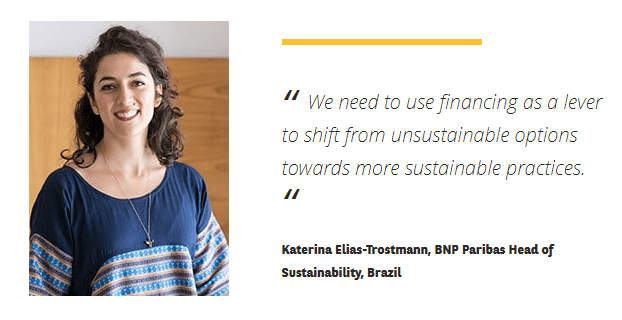Collaborative partnerships and coalitions are key to address zero deforestation in Brazil and to tackle the climate crisis.
One of the key themes emerging from COP26 at Glasgow was the deep interconnection between climate change and biodiversity. Vital to progress in both areas is the adoption of sustainable land practices together with strong actions to stop deforestation, particularly in the Amazon region of Brazil.
Panellists at the recent BNP Paribas Sustainable Future Forum joined Katerina Elias-Trostmann, BNP Paribas Head of Sustainability, Brazil, to explore the issues surrounding deforestation and actions that must be taken to mitigate the crisis and accelerate change in the region.
A crisis not to be underestimated
The depth and scale of the climate change crisis was laid bare in the latest report from the Intergovernmental Panel on Climate Change (IPCC) released earlier in the year. Among its findings were that global surface temperatures were 1.09 degrees Celsius higher in the decade between 2011 and 2020 than during the period dating 1850-1900.
Tasso Azevedo, Global Coordinator at MapBiomas, said that if the Paris COP21 target of limiting global temperature rises to 1.5 degrees Celsius is to be met, then GHG emissions cannot exceed 500 gigatons CO2e between now and the end of the century. Yet annual GHG emissions currently stand at 55 gigatons CO2e, highlighting the urgency of the situation.
“Phase out the use of fossil fuel is paramount but land use management is pivotal to the race to zero. We need to eliminate deforestation and land degradation and foster the CO2 removals by regenerating forest, biomes and soils,” he said.
The impact of climate change on the Amazon Rainforest is already having a devastating impact inside Brazil. Azevedo stressed that the Amazon’s role as a rain regulator is under serious threat, and this is leading to worsening droughts, which in turn leads to a severe effect on the country’s energy and food supplies.
In Brazil, agriculture is mostly rain-fed as opposed to irrigated, but the country has already lost almost 16% of its surface waters in the past 30 years. The current drought has forced Brazil to procure electricity supplies from fossil fuel thermopower plants, as reservoirs supplying hydropower remain low, added Elias-Trostmann. As deforestation of the Amazon creeps to 20% of the biome, this puts the massive ecosystem at risk of the Amazon dieback tipping point, which would see the rainforest transformed into a savannah.
Bold actions are required
Despite this challenge, steps can be taken to mitigate the impacts of climate change. Walter Schalka, CEO of Suzano, warned that concrete action is necessary immediately – as opposed to setting targets for 2050. He urged that illegal deforestation had to stop now, stressing it would result in an instant emissions reduction. Moreover, he said that degraded natural forests needed to be regenerated. In addition, Azevedo made the case for adopting more sustainable and efficient use of land, especially in Brazil, where over 50% of the livestock pasture presents signs of degradation – meaning it is a net source of carbon emissions. In order for this to work, Elias-Trostmann said it was vital to involve farmers and landowners in land regeneration initiatives.
Carbon pricing is another tool that could be deployed to help reduce emissions. Through the establishment of a well-regulated carbon market, companies that exceed their pre-agreed carbon allowances would face harsh penalties – essentially incentivizing a reduction in emissions.
The logistics of making it happen
If such ambitions are to be realised, then some structural changes do need to be made. Gustavo Montezano, President of the Brazilian Development Bank, said that capital mobilisation was not the overriding issue, but rather capital allocation – namely ensuring that cash earmarked for sustainability projects in regions such as the Amazon is actually going to the right places. Brazil has a unique combination to enable this: large natural capital, and a powerful and creative financial market.
Collaboration between multiple stakeholders – including technologists, scientists and NGOs – are vital if the fight against deforestation is to succeed, said Azevedo, and the public and private sectors need to work together closely to accelerate and achieve real change. Furthermore, he suggested that better use of data – especially by financial institutions – would be crucial in ensuring that loans are not directed towards companies engaged in deforestation.

“We need to use financing as a lever to shift from unsustainable options towards more sustainable practices. This can be facilitated through innovation and sustainable financing tools such as green and social bonds along with sustainability-linked instruments,” commented Elias-Trostmann. “In order to succeed, sustainability needs to be integrated and fully embedded in the cultures of companies.”
What is MapBiomas?
MapBiomas – The Brazilian Annual Land Use and Land Cover Mapping Project – is an initiative that involves a collaborative network of universities, tech startups and NGOs. The initiative combines biomes, land use, remote sensing, GIS and computer science experts who rely on the Google Earth Engine platform and its cloud processing and automated classifiers capabilities to generate Brazil’s annual land use and land cover time series. This approach provides insight into understanding all of the transformations in Brazilian territory since 1985.

